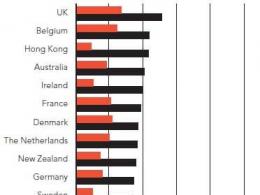Basic functions and tasks of accounting. The concept of accounting, its essence and significance The role and purpose of accounting
Accounting plays a major role in the enterprise management system. Market relations confront enterprises with the need to justify each of their steps. To do this, the management of the enterprise must have objective and complete information about actual costs, the cost of manufactured products, profits received and other factors that affect the economic processes and results of the enterprise. Accounting is used to collect and process such information.
The federal law “on accounting” formulates the main tasks that accounting faces at the present stage of development of economic relations. These tasks include:
Formation of complete and reliable information about the organization’s activities and its property status, necessary for internal users of financial statements - managers, founders and owners of the enterprise’s property, as well as external investors and creditors;
Providing information necessary for internal and external users of accounting statements to monitor compliance with legislation when the organization carries out business operations and their feasibility, the availability and movement of property and liabilities, the use of material, labor and financial resources in accordance with approved norms, standards and estimates;
Preventing negative results from the organization’s economic activities and identifying internal reserves, ensuring its financial stability.
There are two main functions that accounting performs in the enterprise management system:
Information
Test
The information function is one of the main accounting functions. Since accounting is a place where information flows in an enterprise are stopped. It is here that all data on economic activities from different divisions and services of the enterprise is collected, and an overall picture of the state of affairs of the enterprise is formed. All future activities of the enterprise depend on how prompt, complete and accurate the information about resources, income, liabilities, and profits is.
The control function is no less important in accounting. Since accounting reflects all business transactions without exception in a single monetary value, this makes it possible to take into account and control the use of the enterprise’s economic assets and rationally manage them. It is these properties of accounting that make it possible to reflect all changes, both positive and negative, occurring in business activities. The control function allows you to prevent and suppress misuse and abuse, comply with saving regimes, rationally use material and labor resources, and preserve property. In this regard, we can say that the control function of accounting helps to increase the profitability of enterprises.
Accounting is a system of continuous, continuous and interconnected monitoring and control over the economic activities of an enterprise. This is strictly documented accounting. No entry here can be made without the exact execution of the document. Accounting does not allow for selectivity in either time or production. Accounting data is used to monitor and control the economic activities of an enterprise. The economic activity of the enterprise is aimed at the production, distribution, exchange and consumption of material goods necessary for society.
It is possible to manage the economic activities of an enterprise only if there is information about the quantity and quality of economic processes occurring at the enterprise. Primary data on the facts of economic activity are reflected in accounting - this contributes to the systematization of disparate data into a generalized description of certain phenomena of the economic activity of the enterprise, as well as the formation of economic indicators.
Unlike other types of accounting, accounting is systematic. It reflects each completed business transaction in natural, labor and monetary terms. Economic processes are summarized in accounting as the movement of value. This allows you to obtain information about newly created value, and distributions and redistributions.
Information about the profit of an enterprise is generated by comparing the income and expenses of the enterprise in the accounting system. With other types of accounting, this information cannot be obtained.
Accounting plays an important role in assessing accounting objects and determining their cost (calculation). Currently, in the conditions of intensification of social production, improvement of the economic mechanism and, above all, self-supporting relations, economic incentives, control over production and distribution is required. Under these conditions, the importance of accounting information in enterprise management increases even more.
There are internal and external users of accounting data:
Internal ones include the current owners of the company (profit level) and employees of the enterprise (PP). External ones include future owners (profit level); creditors (solvency); clients and buyers (prices); government services (income and level of % deductions) and the public (ecology...)
Accounting is a system that measures, processes and communicates information for decision making. There are management and financial accounting.
Management accounting covers all types of accounting information that is measured, processed and transmitted for internal use by enterprise management. The main function is to determine consistency. Management accounting information should be: useful for management and relatively inexpensive; refers to the part of the enterprise that manages it; include planning for the future.
Financial accounting covers accounting information that, in addition to being used within an enterprise, is communicated to those outside the organization. Conducted in accordance with legislation and established standards. With its help, everything is determined except systematicity, namely: - depreciation; - settlements with other enterprises; - securities accounting; - accounting of funds; - wage; - accounting of banking transactions and others.
Financial accounting applies to the entire enterprise. Users of financial accounting are:
Owners of enterprises, companies (present and future) - they are interested in whether there is a sufficient level of profit in the enterprise;
Creditors - interested in whether the company will pay off its debts on time;
Enterprise employee - salary;
Clients - company prices;
Public service - enterprise income;
The public - whether the enterprise’s activities will lead to an environmental disaster or environmental pollution.
Accounting has given rise to an interesting, creative and well-paid profession. The accountant has a great influence on management decisions. The main task of an accountant is to provide the management of the enterprise with the necessary information for making management decisions. To enhance the efficiency of the enterprise and prevent theft, the accountant is obliged to create an internal control system. He takes part in planning the profit of the enterprise, in drawing up estimates and controlling costs.
Literature:
1. Belousova I.A. Management accounting in the accounting system//Visnik. – Zhitomir. – 2000. - No. 12
2. Sopko V. Accounting form. Navch. Posibnik. – K., 1998
3. Management accounting / Ed. A.D. Sheremeta. – M., 1999
4. Accounting and auditing. Scientific and practical journal No. 12, 2001
LECTURE No. 1. The theory of accounting, its essence and significance in the management system
1. Concept and types of accounting. Indicators used in accounting, functions, objects and tasks of accounting
Accounting is an orderly system for collecting, registering and summarizing information in monetary terms about the property, obligations of organizations and their movement through continuous, continuous and documentary accounting of all business transactions.
Observation represents a general idea of the ongoing economic phenomenon.
Measurement gives a quantitative expression to the ongoing economic phenomenon.
Registration carried out within the established system and facilitates the process of memorizing and studying observed economic phenomena.
Types of accounting:
1) Management Accounting is a type of accounting in which the collection, processing and provision of accounting information for the needs of management at the enterprise occurs. The purpose of management accounting is the formation of an information system at the enterprise.
The main task of management accounting is the preparation of reliable and complete information, which serves as a source for making the necessary management decisions at enterprises in the management process.
The main part of such accounting is the accounting and analysis of costs (cost of manufactured products). Management accounting is closely interconnected with the analysis of ready-made information for the management of the organization (improving the technological production process, optimal cost reduction, etc.).
This information is usually used in the process of making management decisions when planning and forecasting at the enterprise (for financial accounting purposes). The organization's management accounting data is its trade secret and should not be disclosed by its employees;
2) financial Accounting– this is accounting information about the costs and income of the enterprise, about accounts receivable and payable, about the composition of property, about funds, etc.;
3) tax accounting- this is a type of accounting in which information is summarized in order to determine the tax base for taxes based on data from primary documents, grouped in accordance with the procedure provided for by the Tax Code of the Russian Federation (Tax Code of the Russian Federation).
The purpose of tax accounting is to ensure the correctness and reliability of accounting for payments between enterprises and government agencies.
In the process of calculation indicators The activities of an enterprise are widely used to measure its economic assets using meters.
Accounting meter is a specific accounting unit that measures and calculates economic assets and operations in an enterprise.
Maintaining business accounting primarily involves quantitative measurement of the objects being taken into account. For this purpose, accounting meters are used: natural, labor, monetary.
Natural meters serve to reflect in the accounting of economic means and processes in their physical expression, measure, mass. The use of natural meters depends on the characteristics of the objects taken into account, i.e., on their physical properties.
Accounting objects can be measured in units of mass (kilograms, tons, etc.), counting (number of pieces, pairs, etc.). With the help of natural accounting, systematic monitoring of the state of movement of specific types of material assets (fixed assets, finished products, etc.) is carried out and control is exercised over their safety, as well as over the volume of the process of procurement, production and sales of products.
Labor meters used to reflect in accounting the amount of working time spent, calculated in working days, hours, minutes. Labor meters, in combination with natural ones, are used to calculate wages, identify labor productivity, determine production standards, etc.
Money meter occupies a central place in accounting and is used to reflect various economic phenomena and summarize them in a single monetary value. Only with the help of a monetary meter can one calculate the total cost of an enterprise’s heterogeneous property (buildings, machines, materials, etc.). The monetary measure is expressed in rubles and kopecks. Through them, the incurred costs (expenses) of the enterprise, previously expressed in labor and natural measures, are summed up. A monetary meter is necessary, in particular, for calculating the cost of production, determining the profit or loss of an organization, and reflecting the results of economic activity.
Functions, objects and tasks of accounting
Functions accounting:
1) controlling – ensures control over the safety, availability and movement of objects of labor, means of labor, money, over the correctness and timeliness of settlements with the state and its services. With the help of accounting, three types of control are carried out: preliminary, current and subsequent;
2) information function - is one of the main functions, as it is a source of information for all divisions of the enterprise and higher organizations. Information must be reliable, objective, timely and prompt;
3) ensuring the safety of property. The performance of this function depends on the current accounting system, on the availability of specialization, warehouse facilities that are equipped with organizational equipment;
4) feedback function – accounting generates and transmits feedback information;
5) analytical function - with its help, existing shortcomings are revealed, and ways to improve the activities of the organization and its main services are outlined and analyzed.
Accounting objects are:
1) property of the enterprise - fixed assets, intangible assets, etc.;
2) obligations of the enterprise - settlements, transactions, etc.;
3) business transactions – operations related to the activities of the enterprise.
Main tasks of accounting:
1) timely and correct production of necessary payments and obligations;
2) operational control over the correctness and reliability of information in accounting documents;
3) timely reflection of accounting data in accounting registers.
2. Historical overview of the most important stages in the development of accounting
Jean-Baptiste Demarchais (1874–1946) is an outstanding French scientist who created the well-known and popular coat of arms of accountants, which depicts three objects (the sun, the scales and the Bernoulli curve) and the motto “Science - Conscience - Independence”). Each item means something different:
1) sun - illumination of the economic activities of an enterprise with accounting;
2) scales – the importance of balance, its balance;
3) Bernoulli curve – accounting infinity. From about the second half of the XX century. In various countries, scientific directions and schools began to form, which are designed to comprehend and use the accounting craft.
Italian school. This school was mainly dominated by the legal interpretation of accounting. Representatives of this school are F. Villa, F. Marchi, G. Cerboni, G. Rossi and others. They were inclined to believe that the accountant takes into account and controls the activities of the storekeeper, cashier, as well as the rights and obligations of financially responsible persons (at that time they were called agents), the rights and obligations of legal entities and individuals with whom the organization makes payments (at that time they were called correspondents), and not the values of the organization.
Therefore, it was established that the accountant does not reflect the cash in the cash register, not the materials in the warehouse, etc., but the responsibility of the cashier, storekeeper, etc. Each account was personalized, i.e., there was always some responsible person behind it . In this case, the double entry was determined by the rule of E. Degrange, which sounds like this: “The one who issues is credited, the one who receives is debited.”
Already in the twentieth century. The question of the implementation of a special branch of jurisprudence - accounting law - has been repeatedly raised, since an accountant is in some way a judge who applies state law in the process of his work. “Accounting is the algebra of law,” said the outstanding scientist P. Garnier.
French school. Here the economic interpretation of accounting played a significant role. Outstanding representatives of this school are J. Courcelles-Senel, E. Leautay, A. Guilbault, J. B. Dumarchais and others. They saw the main goal primarily in calculating the efficiency of the organization’s economic activities, and not in direct control over the safety of the organization’s values, like many of their Italian accountant colleagues. Using an established methodology, it reflects the movement of fixed capital, all resources, values of the organization, and not their rights and obligations in jurisprudence. It is from this that another explanation for the emergence of double entry follows: there is no receipt of funds without their expenditure - this is what representatives of this school assumed. This assumption was supported by the representative of the school J. Proudhon, who argued that accounting was political economy. He had his own personal opinion: most economists are very bad accountants who know nothing, and also have no understanding of the receipt and expenditure of funds and the maintenance of books.
German school. This school attached great importance to procedural issues, the structure of counting forms, and the sequence of accounting entries. The main representatives of this school were F. Gyugli, I.F. Sher, G. Niklish and others. This school provides for a smooth transition to accounting from the balance sheet to the accounting account, and not vice versa, as was typical for the Italian and French schools. These schools, as stated above, argued that the debit and credit of any accounting account represent “qualitatively homogeneous fields”; the German school, in turn, argue that the meaning of the debit and credit of an accounting account varies depending on the account itself, whether it is passive or active.
American school. This school believed that accounting was a tool for managing people and that people, in turn, managed the organization. From the psychological perspective, accounting information represents the only incentive for administrators, who are required to respond well to this incentive. If this does not happen, then the information has no significance for accounting.
The main achievement of American scientists (G. Emerson, C. Garrison, C. Clark, V. Paton, etc.) was and is the design and implementation of methodological techniques, namely “standard-costing”, “direct-costing” and “ responsibility centers." At the same time, after some time, such a branch of accounting as management accounting was formed.
We can conclude that each of these schools brought its own specific ideas to the science of “Accounting”.
In the accounting life of our country approximately in the first half of the twentieth century. wonderful ideas were included that are still being discussed and improved to this day.
The basis for the existence and development of any society is material production. Production is the starting point of the reproduction process; this is the beginning of the movement of the total product along the chain: production, circulation, consumption. The processes of production, circulation and consumption are continuously repeated, and society at all stages of its development needs information characterizing these processes.
To obtain the necessary information about the progress of business processes, business accounting is organized. It arose from the needs of managing material production: management of economic processes is impossible without knowledge of the specific facts of economic life. Collection of the necessary information about the progress of business processes includes observation, registration of processes, then the obtained indicators are used to control and manage material production processes. Accounting indicators reveal the quantitative and qualitative aspects of the economic process: the volume of manufactured and sold products, the availability of money in the cash register and in accounts, inventories of materials, volumes of fixed assets, profit, etc.
The object of economic accounting is the processes of material production.
Thus, economic accounting is a system of monitoring, measuring and recording material production processes for the purpose of controlling and managing them.
In economic accounting, to determine the quantitative characteristics of an organization’s property, its obligations and business operations, three types of measurements are used: natural, labor and monetary.
Natural meters serve to characterize the objects taken into account in physical terms. Depending on the physical properties of objects, this can be a meter, liter, kilogram, kilowatt-hour, tonne-kilometer, etc. However, using natural meters, it is impossible to obtain generalized characteristics of various objects; they are used only to characterize homogeneous objects.
Labor meters are used to calculate the amount of time spent working, expressed in certain units of time (working days, hours, minutes, etc.). They are used to calculate wages for the organization’s personnel and calculate labor productivity.
The main meter is the monetary meter. it allows you to compare heterogeneous accounting objects and is universal. It is used to summarize property, liabilities and business transactions in a single measurement - in rubles.
There are three types of economic accounting: operational, statistical and accounting, each of which has its own specifics, the range of observed phenomena, tasks and methods of observation. Complementing each other, they form a unified economic accounting system (Fig. 1).
Rice. 1: Business accounting system
Operational accounting used to register, monitor and control individual phenomena of the financial and economic activities of an organization for the purpose of its day-to-day management. With the help of operational accounting, organizations carry out daily operational control over the progress of production and sale of products and the expenditure of the wage fund, timely acquisition of material assets, settlements with suppliers and customers, etc. Such information is necessary for the development of specific recommendations and dispatching.
Statistical accounting reflects and generalizes mass phenomena and their patterns in the financial and economic activities of organizations, social life and nature. It has its own special methods of collecting information (censuses, questionnaires, surveys) and methods of processing this information (grouping, summary, calculation of various indicators: averages, indices, correlation coefficients, etc.). Statistical accounting data is used for economic analysis and forecasting for current and future periods in the context of individual organizations, economic region and country.
Accounting is an orderly system for collecting, registering and summarizing information in monetary terms about the assets, liabilities, income and expenses of an organization and their changes, formed through a continuous, continuous, documentary reflection of all business transactions. Accounting, unlike other types of accounting:
is documented accounting;
continuous in time (day after day) and continuous in coverage of all changes (without any omissions) occurring in the financial and economic activities of the organization;
uses special, unique methods of data processing (accounting, double entry, balance sheet, etc.).
Accounting as a science consists of three independent parts: accounting theory, financial accounting and management accounting.
Accounting theory- a science that studies the theoretical, methodological foundations and practical recommendations for organizing the accounting system as a whole.
Financial accounting is a system for collecting accounting information that provides accounting and recording of business transactions, as well as the preparation of financial statements. Financial accounting data is used internally by managers at various levels and by external users.
Management accounting is designed to collect accounting information that is used within the organization by managers at various levels. Its main goal is to provide the necessary and complete information to managers responsible for achieving specific production results.
Basic requirements for accounting and its tasks
Accounting in all organizations, regardless of their form of ownership, is subject to the same requirements, regulated by various regulatory documents.
- The organization maintains accounting records of property, liabilities and business transactions by double entry on interrelated accounting accounts included in the working chart of accounts, which is approved by the organization on the basis of the Chart of Accounts.
- Accounting for property, liabilities and business transactions of organizations is carried out in the currency of the Russian Federation - in rubles. Documentation of property, liabilities and other facts of economic activity, maintenance of accounting registers is carried out in Russian.
- Compliance with the adopted accounting policies during the reporting year is mandatory for all organizations. This policy generally includes the following requirements: completeness; timeliness, prudence, priority of content over form, consistency, rationality.
- In accounting, current costs for production of products, performance of work and provision of services and costs associated with capital and financial investments are taken into account separately.
- Property owned by an organization is accounted for separately from the property of other legal entities owned by the organization.
- Accounting is maintained by an organization continuously from the moment of its registration as a legal entity until reorganization or liquidation in the manner established by the legislation of the Russian Federation.
- Responsibility for organizing accounting in organizations, presenting financial statements, complying with legislation when carrying out business transactions, and ensuring mandatory audits in cases established by the legislation of the Russian Federation are borne by the heads of organizations.
Accounting tasks face the following tasks:
- generation of complete and reliable information about the organization’s activities and its property status, necessary for internal and external users of financial statements.
- providing information necessary to monitor the organization’s compliance with the legislation of the Russian Federation when carrying out business operations and their expediency; the presence and movement of property and liabilities; use of material, labor and financial resources in accordance with approved norms, standards and estimates;
- timely prevention of the emergence of negative phenomena in the financial and economic activities of organizations, identification and mobilization of intra-economic reserves and forecasting of the organization’s performance for the current period and for the future;
promoting competition in the market in order to obtain maximum profits.
Users of accounting information can be divided into two groups: internal and external.
Internal users- persons employed in the management apparatus, owners, managers who need accounting information to plan, control and evaluate business operations.
External users- third-party consumers of information with direct or indirect financial interest. They are divided into the following groups:
persons who do not work in the organization, but are directly interested in its successful activities (shareholders, investors, creditors, buyers, etc.);
persons who do not directly participate in the work of the organization, but have an indirect financial interest: tax service, government authorities, various financial institutions and stock market participants (insurance companies, exchanges, dealers, brokers, etc.);
persons who have no financial interest other than business cooperation: audit firms, statistical authorities, arbitration, etc.
Organization of accounting, its legal and methodological support
The head of the organization is responsible for organizing accounting and complying with the law when carrying out business operations.
General legal and methodological guidance of accounting in Russia is carried out by the Government of the Russian Federation and the Ministry of Finance of the Russian Federation. The system of legal and methodological regulation of accounting is based on maintaining a four-level system of regulatory documents.
Accounting in the organization is carried out by the accounting department, headed by the chief accountant; when the organization does not have an accounting service, the manager has the right to entrust the maintenance of accounting and reporting to a specialized organization or relevant bodies (specialists) on a contractual basis (this mainly applies to small organizations).
The chief accountant is appointed to the position (removed from the position) by the head of the organization and reports directly to him. In his work, he must be guided by regulatory documents, and also bear responsibility for compliance with the uniform legal and methodological principles of accounting contained therein.
The chief accountant is responsible for the formation of accounting policies, ensures control over its implementation, the movement of assets, the formation of income and expenses and the fulfillment of obligations and the reflection of business operational information on the accounting accounts, the preparation of financial statements in a timely manner, and the holding (together with other services) economic analysis of financial and economic activities in order to identify the organization’s internal reserves.
The chief accountant is prohibited from accepting for execution and registration documents on transactions that contradict the law and violate contractual and financial discipline. The chief accountant informs the manager in writing about such documents, who may, by written order, oblige the acceptance of these documents for execution; from this moment on, the head of the organization bears responsibility for the illegality of transactions performed.
The requirements of the chief accountant for documenting business transactions and submitting documents and information (information) to the accounting service are mandatory for all employees of the organization.
In recent years, a new concept has often appeared in the accounting literature - the accounting principle.
The principle is the basis, the initial, basic position of accounting as a science, which predetermines all subsequent statements arising from it.
Basic Accounting Principles
The basic principles of accounting are:
The principle of autonomy presupposes that an organization exists as a single independent legal entity; its property is strictly separated from the property of its co-owners, employees and other organizations.
The principle of double entry is a double continuous reflection of economic phenomena, facts and transactions, predetermined by the use of double entry in accounts, i.e. simultaneously and for the same amount in the debit of one account and the credit of another account.
The principle of a functioning organization assumes that the organization is functioning normally and will maintain its position in the market in the foreseeable future, paying off obligations to suppliers and consumers and other partners in the prescribed manner.
The principle of objectivity (registration) - all business transactions must be reflected in accounting, be registered throughout all stages of accounting, and be confirmed by supporting documents on the basis of which accounting is carried out.
The principle of prudence (conservatism) is a certain degree of caution in the process of forming judgments necessary in calculations made under conditions of uncertainty, allowing one to avoid overestimating assets or income and underestimating liabilities or expenses.
The accrual principle (conditional facts of economic activity) - transactions are recorded as they occur, and not at the time of payment, and relate to the reporting period when the transaction was completed.
The principle of periodicity is a regular, periodically repeated balance sheet summary - drawing up a balance sheet and reporting for the year, half a year, quarter, month.
The principle of confidentiality. The content of internal accounting information is a trade secret of the organization; for disclosure and damage to its interests, liability is established by law.
The principle of monetary measurement is the quantitative measurement and calculation of facts of economic activity and production processes. The unit of measurement is the country's currency.
The principle of continuity in accounting is a reasonable commitment to national traditions, achievements of domestic science and practice.
Alphabetical index
Alphabetical index
- 2035 views
Accounting is assigned main role in the enterprise management system. Market relations confront enterprises with the need to justify each of their steps. To do this, the management of the enterprise must have objective and complete information about actual costs, the cost of manufactured products, profits received and other factors that affect the economic processes and results of the enterprise. To collect and process such information, the enterprise uses accounting.
The Federal Law “On Accounting” dated November 21, 1996 No. 129-FZ formulates the main tasks that accounting faces at the present stage of development of economic relations.
TO such tasks relate:
generation of complete and reliable information about the organization’s activities and its property status, necessary for internal users of financial statements - managers, founders and owners of the organization’s property, as well as external users - investors, creditors, etc.;
providing information necessary for internal and external users of financial statements to monitor compliance with the legislation of the Russian Federation when the organization carries out business operations and their feasibility, the availability and movement of property and liabilities, the use of material, labor and financial resources in accordance with approved norms, standards and estimates;
preventing negative results from the organization’s economic activities and identifying internal reserves, ensuring its financial stability.
The following are distinguished main functions, which perform accounting in the enterprise management system:
Information function is one of the main functions of accounting. And this is understandable, since accounting is the intersection of information flows in an enterprise. It is here that all data on economic activities from different divisions and services of the enterprise is collected, and an overall picture of the state of affairs of the enterprise is formed. All future activities of the enterprise depend on how prompt, complete and accurate the information about resources, income, liabilities, and profits is. Without such information, it is impossible to solve current problems, much less make plans for the future.
Test function is no less important in accounting. Since accounting reflects all business transactions without exception in a single monetary value, this makes it possible to take into account and control the use of the enterprise’s economic assets and rationally manage them. It is these properties of accounting that make it possible to reflect all changes, both positive and negative, occurring in business activities. The control function allows you to prevent and suppress misuse and abuse, comply with saving regimes, rationally use material and labor resources, and preserve property. In this regard, we can say that the control function of accounting helps to increase the profitability of enterprises.
Accounting in all organizations, regardless of their form of ownership, is subject to the same requirements, regulated by various regulatory documents:
The organization maintains accounting records of property liabilities and business transactions by double entry on interrelated accounting accounts included in the working chart of accounts, which is approved by organizations on the basis of the Chart of Accounts.
Accounting for property, liabilities and business transactions of organizations is carried out in the currency of the Russian Federation - rubles. Documentation of property, liabilities and other facts of economic activity, maintenance of accounting registers is carried out in Russian.
Compliance with the adopted accounting policies during the reporting year is mandatory for all organizations.
This policy generally includes the following requirements: completeness;
Property owned by an organization under proprietary rights is accounted for separately from the property of other legal entities owned by the organization.
Accounting is maintained by the organization continuously from the moment of its registration as a legal entity until reorganization or liquidation in the manner established by the legislation of the Russian Federation.
Responsibility for organizing accounting, presenting financial statements, complying with the law when carrying out business operations, and ensuring mandatory audits in cases established by the legislation of the Russian Federation are borne by the heads of organizations.






